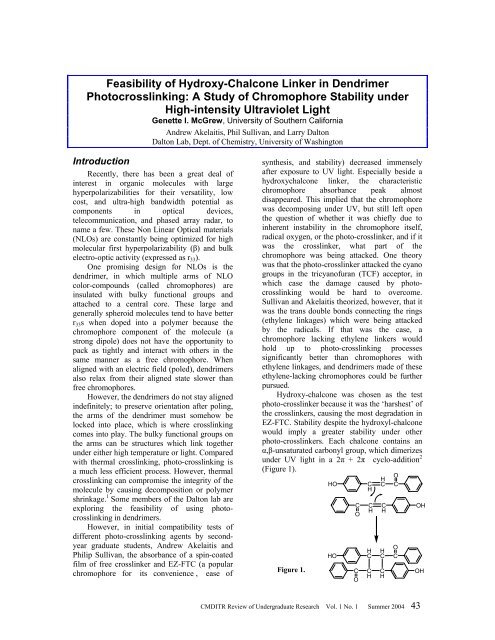CMDITR Review of Undergraduate Research - Pluto - University of ...
CMDITR Review of Undergraduate Research - Pluto - University of ...
CMDITR Review of Undergraduate Research - Pluto - University of ...
You also want an ePaper? Increase the reach of your titles
YUMPU automatically turns print PDFs into web optimized ePapers that Google loves.
Feasibility <strong>of</strong> Hydroxy-Chalcone Linker in Dendrimer<br />
Photocrosslinking: A Study <strong>of</strong> Chromophore Stability under<br />
High-intensity Ultraviolet Light<br />
Genette I. McGrew, <strong>University</strong> <strong>of</strong> Southern California<br />
Andrew Akelaitis, Phil Sullivan, and Larry Dalton<br />
Dalton Lab, Dept. <strong>of</strong> Chemistry, <strong>University</strong> <strong>of</strong> Washington<br />
Introduction<br />
Recently, there has been a great deal <strong>of</strong><br />
interest in organic molecules with large<br />
hyperpolarizabilities for their versatility, low<br />
cost, and ultra-high bandwidth potential as<br />
components in optical devices,<br />
telecommunication, and phased array radar, to<br />
name a few. These Non Linear Optical materials<br />
(NLOs) are constantly being optimized for high<br />
molecular first hyperpolarizability (β) and bulk<br />
electro-optic activity (expressed as r 33 ).<br />
One promising design for NLOs is the<br />
dendrimer, in which multiple arms <strong>of</strong> NLO<br />
color-compounds (called chromophores) are<br />
insulated with bulky functional groups and<br />
attached to a central core. These large and<br />
generally spheroid molecules tend to have better<br />
r 33 s when doped into a polymer because the<br />
chromophore component <strong>of</strong> the molecule (a<br />
strong dipole) does not have the opportunity to<br />
pack as tightly and interact with others in the<br />
same manner as a free chromophore. When<br />
aligned with an electric field (poled), dendrimers<br />
also relax from their aligned state slower than<br />
free chromophores.<br />
However, the dendrimers do not stay aligned<br />
indefinitely; to preserve orientation after poling,<br />
the arms <strong>of</strong> the dendrimer must somehow be<br />
locked into place, which is where crosslinking<br />
comes into play. The bulky functional groups on<br />
the arms can be structures which link together<br />
under either high temperature or light. Compared<br />
with thermal crosslinking, photo-crosslinking is<br />
a much less efficient process. However, thermal<br />
crosslinking can compromise the integrity <strong>of</strong> the<br />
molecule by causing decomposition or polymer<br />
shrinkage. 1 Some members <strong>of</strong> the Dalton lab are<br />
exploring the feasibility <strong>of</strong> using photocrosslinking<br />
in dendrimers.<br />
However, in initial compatibility tests <strong>of</strong><br />
different photo-crosslinking agents by secondyear<br />
graduate students, Andrew Akelaitis and<br />
Philip Sullivan, the absorbance <strong>of</strong> a spin-coated<br />
film <strong>of</strong> free crosslinker and EZ-FTC (a popular<br />
chromophore for its convenience , ease <strong>of</strong><br />
synthesis, and stability) decreased immensely<br />
after exposure to UV light. Especially beside a<br />
hydroxychalcone linker, the characteristic<br />
chromophore absorbance peak almost<br />
disappeared. This implied that the chromophore<br />
was decomposing under UV, but still left open<br />
the question <strong>of</strong> whether it was chiefly due to<br />
inherent instability in the chromophore itself,<br />
radical oxygen, or the photo-crosslinker, and if it<br />
was the crosslinker, what part <strong>of</strong> the<br />
chromophore was being attacked. One theory<br />
was that the photo-crosslinker attacked the cyano<br />
groups in the tricyan<strong>of</strong>uran (TCF) acceptor, in<br />
which case the damage caused by photocrosslinking<br />
would be hard to overcome.<br />
Sullivan and Akelaitis theorized, however, that it<br />
was the trans double bonds connecting the rings<br />
(ethylene linkages) which were being attacked<br />
by the radicals. If that was the case, a<br />
chromophore lacking ethylene linkers would<br />
hold up to photo-crosslinking processes<br />
significantly better than chromophores with<br />
ethylene linkages, and dendrimers made <strong>of</strong> these<br />
ethylene-lacking chromophores could be further<br />
pursued.<br />
Hydroxy-chalcone was chosen as the test<br />
photo-crosslinker because it was the ‘harshest’ <strong>of</strong><br />
the crosslinkers, causing the most degradation in<br />
EZ-FTC. Stability despite the hydroxyl-chalcone<br />
would imply a greater stability under other<br />
photo-crosslinkers. Each chalcone contains an<br />
α,β-unsaturated carbonyl group, which dimerizes<br />
under UV light in a 2π + 2π cyclo-addition 2<br />
(Figure 1).<br />
Figure 1.<br />
HO<br />
HO<br />
C<br />
H<br />
H<br />
C<br />
C C<br />
H<br />
C<br />
H<br />
O<br />
H<br />
C H O<br />
C C<br />
C C<br />
H<br />
C<br />
H<br />
O<br />
O<br />
C<br />
OH<br />
OH<br />
<strong>CMDITR</strong> <strong>Review</strong> <strong>of</strong> <strong>Undergraduate</strong> <strong>Research</strong> Vol. 1 No. 1 Summer 2004 43




